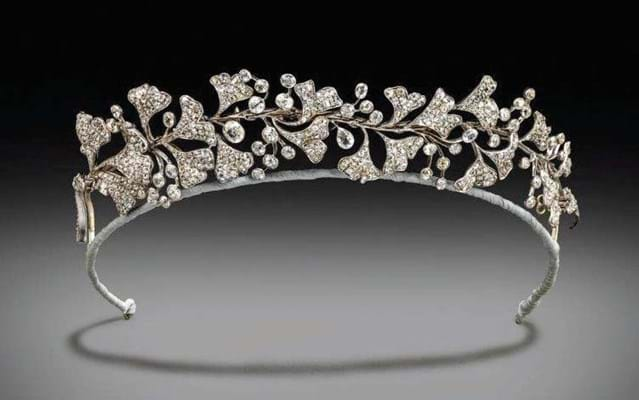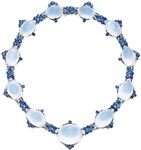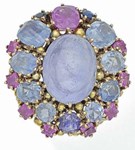The most desirable are the more wearable and delicate versions and particularly those that convert well to necklaces. It has given a lease of life to a much-admired but somewhat redundant form.
Woolley & Wallis (22% buyer’s premium) had six in its April 27 sale.
A classic late-19th century fringe necklace with a line of 37 cushionshaped diamonds came in a case by Cartier containing the fittings, allowing it to be worn as a tiara. A purchase invoice from Cartier dated July 4, 1960, was made out for £900.
In Salisbury, estimated at £8000-12,000, it took £25,000 from a London family.
Estimated at £10,000-15,000, a late Victorian diamond set floral tiara mounted in silver and gold on a detachable frame posted £55,000. It was much admired for its decorative scheme of pavé-set ginkgo leaves – symbol of longevity, hope, resilience and peace – set with larger cushionshaped diamond berries.
Named pieces
Strong prices continue for named pieces, including a tutti-frutti Deco giardinetto brooch in the Japanese style by Cartier which sold for £24,000 despite its later pin. Meanwhile, overseas interest continues to dominate with sterling still trading at a weak level. However. specialist Jonathan Edwards thought some of the froth has settled at the top of the stones market.
“Some things that were overheating are coming back down to reality,” he said. “The rise has stopped.” Pearls in particular are not quite the force they were.
The five-row necklace, with a report from the SSEF in Switzerland stating that the 668 graduated pearls sized from 2.65 to 7.4mm were natural saltwater, would have done better than its £50,000 hammer price a couple of years ago.
Spinel surprise
There are, however, buyers for whom prices for classic gemstones have gone too high, and who have sought refuge in other areas of the market. Natural red spinels (often found together with the rubies with which they were once confused) have accelerated in recent times.
Here, a ring with a GCS report stating that the octagonal-cut stone weighs approximately 8.30cts, and showing no indications of heat treatment, took £17,000 (estimate £2000-3000). The sale totalled £1.2m with 84% of the lots sold.


















